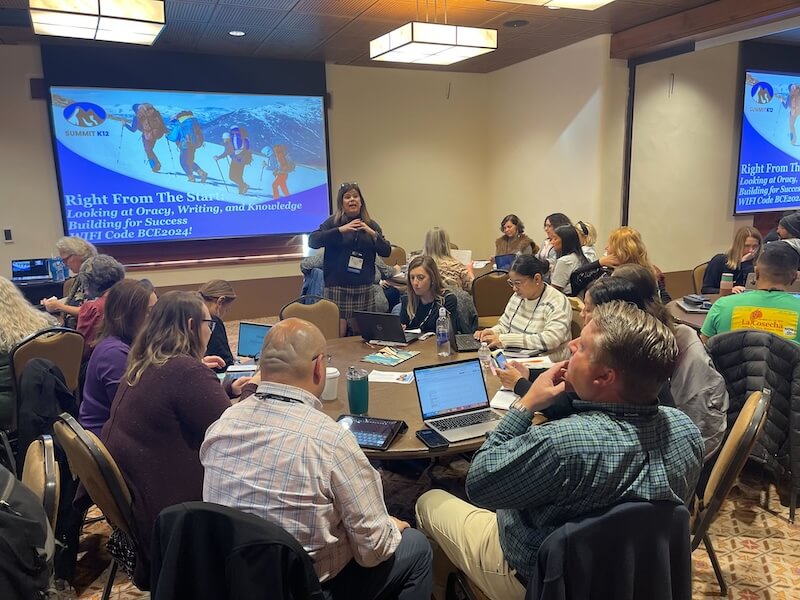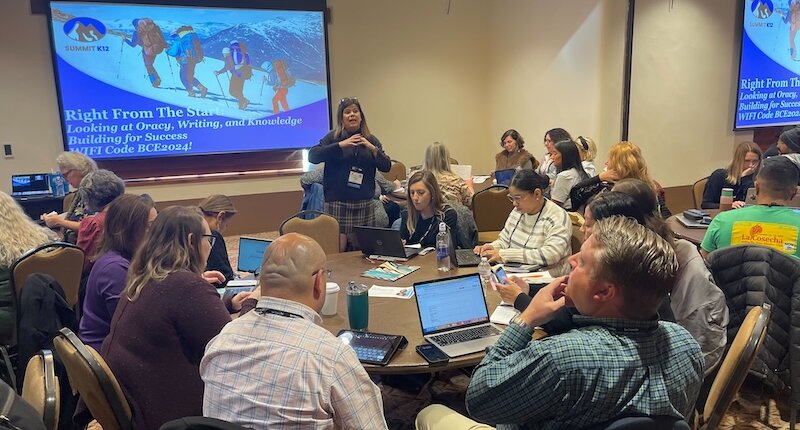In Shift 1, we challenged the old adage, “In K–3, children are learning to read, and in 4–12, children are reading to learn,” and called for the integration of “Learning to Read” and “Reading to Learn” for Lifelong Success. In Shift 2, we challenged the notion that teaching word recognition and decoding skills should happen in isolation and call for early reading instruction that connects phonemes and graphemes to word meanings in rich, meaningful contexts. In Shift 3, we challenge simplistic views of reading in favor of more complex ecologies that take into consideration the interactive and reciprocal developmental relations between languages, cognition, and literacy skills. In the intricate dance of decoding words and grasping their meanings lies the essence of reading comprehension or does it? The field continues to be captivated by the Simple View of Reading (SVR), a framework positing that reading comprehension comprises two broad constructs, word recognition (decoding in the original SVR) and language comprehension and (Gough & Tunmer, 1986). Today, we delve deeper into the complexity of reading as research suggests a more nuanced understanding, one that acknowledges the dynamic interplay between word reading and language comprehension. Far from being independent entities, these skills are intricately linked, with research revealing their moderate to strong correlation (Foorman et al., 2015). Let’s start with the end in mind. Pearson and Liben argue that “When comprehension occurs optimally, it is driven by readers’ knowledge and their highly automated processing skills; readers know that a text they are reading “makes sense” when their interpretation of the text is consistent with what they know to be true about the world and what they just read a moment ago… But when their standard for coherence is not met—when the text stops making sense to them—readers must take stock, reconsider options, and look for ways to achieve the coherence they seek.” What learning experiences are necessary to ensure Multilingual Learners (MLLs) develop language, skills, knowledge, and reading comprehension in order to grow continuously throughout their schooling to meet increasing demands placed upon them? “Language develops as a result of meaningful participation in human interaction.” For Multilingual Learners (MLLs), language development may predominantly occur in languages other than English. As MLLs enter U.S. schools, they may require additional support in English language development (ELD) to increase students’ engagement and interaction with peers, content and ideas. While children’s linguistic backgrounds and proficiency levels in English vary greatly, their home language is an asset that reflects the rich tapestry of linguistic diversity present in today’s classrooms, and ELD support provided must capitalize on the joys and benefits of being bilingual. Learning in two languages has been linked to several cognitive and linguistic benefits, including improved metalinguistic awareness, which enhances understanding of how language functions (Bialystok, 1988), a stronger ability to multitask (Bialystok, 2011), and a greater capacity for acquiring additional languages (Cenoz & Valencia, 1994). Dual language programs offer several long-term advantages. Recent reports determined that studies comparing English learners (ELs) in English-only programs with those in bilingual programs either show no significant difference in English proficiency or demonstrate that bilingual program students outperform their English-only counterparts (Cummins 2025). Because many students are served in English only settings, Cummins 2025 calls for language-friendly and literacy-friendly instructional policies and practices, which can be implemented within both English-only programs and dual language programs, with benefits for both multilingual and monolingual English-speaking students. Learning a new language is a complex and dynamic process that often does not follow a linear progression (Valdés et al., 2014). It is paramount for children to be exposed to rich language, vocabulary and complex sentences on a daily basis. Teachers play a pivotal role in this regard; they should refrain from simplifying their oral language or over-scaffolding when communicating with MLLs. Instead, they should actively incorporate and teach complex words, engaging children in meaningful back-and-forth conversations and discussions that foster higher-order thinking skills such as perspective-taking. Research indicates a stark reality in that a very small percentage of is spent on conversations that promote oral language development, and oral language instruction is often neglected in educational settings, decontextualized or taught in bits and pieces. Kim (2015) found that, on average, a mere 5 minutes per day are allocated to teaching oral language. Furthermore, many teachers exhibit gaps in their knowledge of oral language structure, with a significant number lacking adequate training in oral language acquisition and instruction. Reading Comprehension: In the quest to conceptualize the complex phenomenon we call reading comprehension, let’s consider the following story: A retired violinist, known for her lifelong attachment to her cherished instrument, fell ill in her final days. She told her granddaughter, “Promise me, when I’m gone, you’ll keep the violin safe and close to your heart.” The granddaughter nodded solemnly, knowing how much it meant to her grandmother. After the funeral, the granddaughter hosted a small gathering at her home, where family and friends shared memories. As the evening wound down, a close family friend pulled the young woman aside. “I hope you honored her wishes about the violin,” the friend said gently. The granddaughter smiled and replied, “Of course I did. I placed it where it belongs.” Intrigued, the friend raised an eyebrow. “So, it’s… in a case somewhere safe?” “No,” the granddaughter said softly. “I donated it to the local music school.” The friend looked stunned. “But… she said to keep it safe and close to your heart!” The granddaughter gave a knowing smile. “And I did keep my promise. What could be safer and closer to her heart than having it played by children who love music as much as she did?” Understanding the essence of this story entails more than just deciphering the words on the page. It’s about seamlessly weaving together the meanings of those words while simultaneously processing new information and holding it in memory. Understanding the ideas and their connections – bridging them and making the necessary inferences – is the work of the reader. It requires the reader to infer that the granddaughter didn’t keep the violin in a safe place for herself, despite her promise. The narrative never explicitly states that donating the violin was the right choice, but readers need to connect the grandmother’s values (love for music) with the granddaughter’s reasoning. The twist hinges on understanding that honoring a promise doesn’t always mean literal obedience; it can involve interpreting the spirit of the request. This story plays on the idea that readers use background knowledge (the importance of legacy and music education) to infer deeper meanings beyond what’s said outright. The author assumes their readers know things, so readers knowing things is a crucial component of readers’ success and continued comprehension gains. This anecdote underscores the intricate nature of language comprehension, showcasing how it hinges on a web of sophisticated cognitive skills: working memory, attentional control, vocabulary, background knowledge, perspective-taking, and more. Reading comprehension, then, emerges as a multifaceted endeavor, demanding a comprehensive understanding of the diverse skills and knowledge interwoven within its fabric – within and beyond the text. Multilevel Comprehension Model, Kintsch (1988) suggests that effective comprehension requires readers forming a mental representation of the text they engage with. This mental representation operates on three distinct levels: the surface level (the literal wording of the text), the textbase (which includes inferences made by the reader), and the situation model (the integration of explicit and implicit text information with readers’ background knowledge). As students read, these three levels develop simultaneously. The ability to create these layers of understanding relies on students’ skills in extracting ideas or propositions from the text, making inferences, and integrating prior knowledge to textbase inferences in order to construct a model of the situation described in the text. Kintsch’s model assumes that “what is formed in the readers’ mind during comprehension goes well beyond the literal meaning” and encapsulates readers’ background knowledge and experience. In addition to making inferences, strong readers also are driven by a desire to derive meaning from texts. This characteristic is often referred to as having a “standard of coherence” reflects the reader’s expectation to understand the author’s message and their willingness to engage deeply to achieve that understanding. Readers make inferences to connect different parts of a text and construct a coherent mental representation. Skilled readers actively monitor their comprehension and learn to use the right strategies for the right tasks and texts to overcome inconsistencies or conflicts with their existing knowledge. Students who cultivate this standard of coherence mindset tend to seek a more comprehensive grasp of the material than those who have not yet developed this conviction. These students are more likely to recognize when they miss critical inferences and will actively work to address any obstacles to their comprehension. Knowledge aids students in building a mental model; it fills the gaps in what the text leaves unsaid. Take this example provided by David and Meredith Liben using this excerpt from a childhood favorite, Charlotte’s Web: “Where’s Papa going with that ax?” said Fern to her mother as they were setting the table for breakfast. “Out to the hog house,” replied Mrs. Arable. “Some pigs were born last night.” “I don’t see why he needs an ax,” continued Fern, who was only eight. “Well,” said her mother, “one of the pigs is a runt. It’s very small and weak, and it will never amount to anything. So, your father has decided to do away with it.” Students unfamiliar with the meaning of ax, hog house, runt, “amount to anything,” or “do away with it” would struggle to understand what is happening in this snippet. On the other hand, if students have all the knowledge the author has assumed, inferences will be automatic. They will quickly make a bridging inference back to the ax (realizing it will be used to kill the pig/runt and identifying with Fern’s horror). The reader also needs to connect propositions that aren’t close together in the text. This conversation refers to what happened 5 pages: “Can I have a pig too, Pop?” asked Avery. “No, I only distribute pigs to early risers,” said Mr. Arable. “Fern was up at daylight, trying to rid the world of injustice. As a result, she now has a pig. A small one, to be sure, but nevertheless, a pig…” This brief example clarifies the role of prior knowledge in filling gaps in the text. It also explains that this process is not limited to informational texts since this example is highly narrative. No author includes every detail, regardless of their desire to make content accessible. If they were to do so, the resultant writing would be so ponderous as to be unreadable or uninviting. Skilled readers have the habit of actively monitoring comprehension and making inferences. When the standard of cohesion or comprehension breaks down, students need to know which strategies to apply based on the type of text and the task at hand. While strategies may initially be introduced one at a time, instruction should quickly shift focus to using strategies in the context of the task and text. This enables students to select the most effective approach for any specific text or task. With practice, strategies evolve into automatic skills, though challenging texts may still require conscious effort. Over time, exposure to diverse, progressively difficult texts supports both the breadth and depth of students’ understanding, helping them become proficient, independent readers. By embracing a more comprehensive and integrated perspective, educators can better tailor their approaches to foster optimal reading outcomes for learners of all backgrounds and abilities. We want better literacy outcomes and instructional time is limited. The Science of Reading movement has been really successful in creating demand for change. Since 2020, more than 40 states have passed “Science of Reading” legislation. This national movement to improve literacy is a testament of how dissatisfied people were with the status quo, but the job is not over, especially when it comes to multilingual learners. To move forward, we must address the overteaching of foundational skills and how it could squeeze time for other learning opportunities such as syntax, book language, sentence comprehension, comprehension of whole passages or reading itself. Even for young readers who are beginning to read, the reader is trying to make sense of sentences by figuring out who did what to whom. In Shift 3, we challenge simplistic views of reading in favor of more complex views that take into consideration the interactive and reciprocal developmental relations between languages, cognitive processes, and comprehension skills and propose that this is where the Science of reading needs to go next. In moving beyond a simplistic view of reading, we recognize the complexity of language and literacy as a dynamic process, especially for multilingual learners (MLLs). The Simple View of Reading (SVR) underscores the importance of both decoding and linguistic comprehension. However, when applied to MLLs, this model alone does not fully account for the nuanced and evolving nature of multilingual and multiliterate development. Reading for MLLs, and indeed for all learners, involves building learning a new language, understanding book language, developing standard of coherence, constructing a situation model, activating background knowledge, and strategically using cognitive processes to engage with and understand texts. Kintsch’s model reminds us that reading is not a passive absorption of words but an active, interactive process. A learner selects relevant information from what is presented and constructs mental representations of the text. This process is moderated by individual differences, such as vocabulary, prior knowledge, exposure to book language, preferences, and strategies. Proficient readers continuously integrate new ideas with prior knowledge, constructing and refining a mental model of the text as they read. This evolving model enhances their understanding, enabling them to gain insights and see connections that make reading a rich, engaging, and powerful learning experience. By embracing this more complex ecology, educators, researchers, and policymakers can better support all learners on their journey toward true reading proficiency. Let’s shift away from a simplistic theoretical reading model and embrace models that recognize the complexities involved. Only then we can create systems of opportunity where every learner’s potential is realized.

Creating Systems of Opportunity for Multilingual Learners (MLLs)
Shift 3: Moving Beyond Simplicity and Sound Bites in Reading InstructionWritten by: Amelia Larson, Chief Academic Officer, Summit K12
Beyond Simplicity to Get There
—Duff, 2010Oral Language
Access
Oracy
Research
Moving Forward:

Standard of Coherence

Strategies
Research
Instructional Implications
Embracing Complexity
Key Takeaways
Explore Summit K12 Solutions







